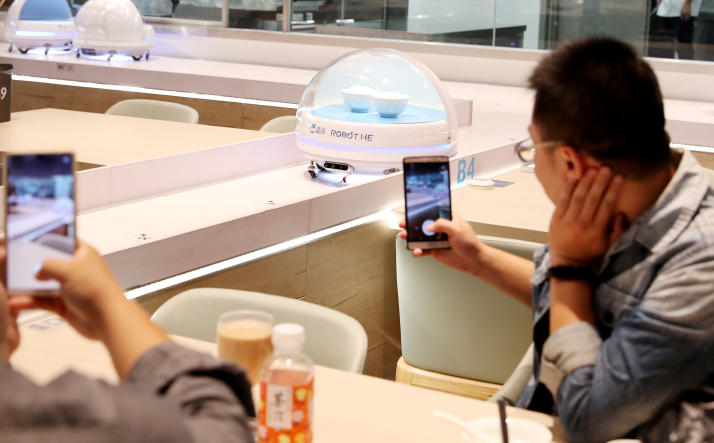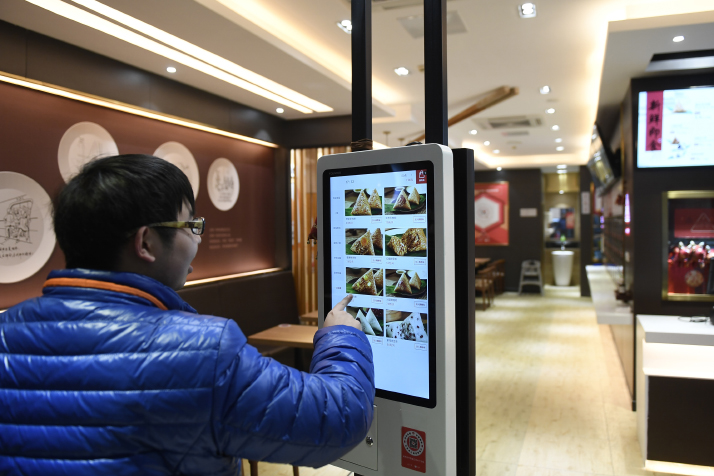| Business |
| What's for Dinner? | |
| Mobile Internet is changing the way catering businesses operate | |
|
|
 People take photos of robots delivering food at a restaurant in Shanghai on October 15, 2018(XINHUA)
For Jiang Ying, a resident in Nanjing, east China's Jiangsu Province, picking a restaurant for a family dinner is a decision which includes many requirements. Her parents, both in their 60s, prioritize the quality and safety of food, while her 4-year-old son loves theme restaurants with entertainment facilities. Jiang focuses more on restaurant evaluations provided by other customers. "Service is also very important," she said. "It is better if the restaurant can be reserved online or by a mobile app." All of Jiang's concerns can now be met as a new pattern has developed in the catering industry in recent years. "There is a lot of information on Dianping.com or from WeChat posts. Based on the ratings of a selection of candidates, I can find the restaurant that meets my needs," Jiang said. Dianping.com is a customer review website and WeChat is China's largest social media platform. Except for actual eating, almost the whole process of dining at a restaurant can be done by mobile phone, from making a reservation and paying to posting an evaluation. A promising sector Unlike the traditional retail industry which is being adversely affected, the catering industry is embracing the changes brought about by the Internet. According to a list of good restaurants in 2018 unveiled by the China Hospitality Association (CHA), the industry has shown a trend toward New Retail. Through the combination of online and offline services, a new growth driver is being created for catering enterprises. It is expected that in the next three to five years, smart technology will be widely used in the industry, improving its quality and efficiency. In 2018, China's catering revenue exceeded 4 trillion yuan ($581 billion), up 9.5 percent year on year. In the first four months of this year, it was nearly 1.4 trillion yuan ($203.4 billion), increasing 9.3 percent year on year. According to Workers' Daily, China's catering revenue will top 7 trillion yuan ($1.02 trillion) by 2023. Additionally, the income from catering accounted for 10.8 percent of the total retail sales of consumer goods in the first four months of this year. Currently, eating is no longer just a necessity, but also a pursuit for comprehensive enjoyment including taste, environment and personal experience. Thus, simply providing food will not help catering enterprises survive fierce market competition. They must create a scene that consumers can recognize and integrate into. For example, a Starbucks cafe in Shanghai decided to get customers up to date on the whole process of coffee making and is now the world's bestselling store.  A customer orders food at a smart restaurant in Hangzhou, east China's Zhejiang Province, on February 2, 2018 (XINHUA)
Meeting various needs According to Tang Qingshun, President of the Beijing Food and Beverage Industry Association, customers aged between 20 and 40 constitute the largest share of catering consumption in China. "This group has reached nearly 600 million. Eating for them is no longer only for living, but also part of a lifestyle," Tang told Beijing Review. For example, because of their fast-paced life, a lot of young people, especially those who work in emerging hi-tech industries such as information technology, cannot spare enough time for breakfast and lunch. "Dinner is the time for them to relax and enjoy social activities," Tang said. In addition, according to a survey conducted in 2016 by China Youth Daily, the new generation is very fond of taking pictures during meals. Over 40 percent of the post-1990s generation had this habit, while the proportion for the post-1980s generation was 38.4 percent and for people born in the 1970s, it was 24.7 percent. Furthermore, since the new generation shows huge social attributes, sales at physical restaurants are not only of single food items but also cultural experiences attached to certain brands. Today, consumers can find more brand restaurants in shopping malls, which are growing into people's best choices and combining both delicacies and a sound environment. Delivery also plays an essential role in the new trend of catering. On June 14, 2018, Meituan, an on-demand service platform, delivered 280,000 bottles of beer and 1.53 million crayfish on the opening night of the FIFA World Cup Russia. Affordable restaurant franchises, in particular, account for more than a quarter of Meituan's food delivery orders. A survey conducted by iResearch, a consumer insight provider in China, showed the proportion of people born in the 1990s who cook at home less than four times a week was 42.5 percent in 2018. "I used to order food on online platforms frequently when I lived alone," Jiang said, "Although I didn't know how to cook, I could still enjoy all kinds of food at home." As part of the new trend of catering, instant food products such as hotpots are also popular in the market. Healthy growth In recent years, despite its strong development, China's catering industry is still facing problems such as increasing store rental and labor costs. Thus, it is necessary to relieve these burdens. Han Ming, President of the CHA, told People's Daily that nearly 20 taxes and administrative fees in the catering industry have been reduced to varying degrees, including corporate income tax. According to a 2018 report, more than 80 percent of catering companies surveyed benefited from these tax reductions. Considering the development of the catering industry itself, Tang said although young people currently prefer to try restaurants that cyber celebrities recommend, the trend will not last forever. He believes advanced technologies and a nice interior design cannot be the core of the new industrial trend. For the majority of online sensational businesses, the quality of dishes should be enhanced rather than focused on introducing fresh elements. For time-honored restaurants that also take in new elements to improve their services, Tang suggested that they stick to their positioning and consider consumer demand for food safety. "Actually, the things you eat and buy have not changed. What has changed is the process and procedures of consumption," he said. Industry insiders agree that customer profiling can help restaurants establish a clear idea of their service targets, for example, simply serving food quickly or offering high-end services and experiences can make a major difference. The operation strategies may even vary according to different locations, highlighting the traditional advantages of these restaurants including their dishes and basic business modes so that they can have a greater role in the new era. Establishing a brand is what all catering companies should strive for in this period. People are willing to accept higher-priced branded goods in place of non-branded products at affordable prices. In addition, it is necessary to create an innovative business mode which makes full use of the New Retail model to bring convenience to people. Tang also reminded consumers when facing diverse choices that they must make rational decisions and pay enough attention to conservation and environmental protection. Copyedited by Rebeca Toledo Comments to liqing@bjreview.com |
|
||||||||||||||||||||||||||||
|
